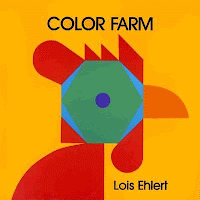Lois Ehlert is a creative
storyteller who often uses shapes, die cuts, and collage. Color Zoo and Color Farm stack window
die cut shapes on top of each other to create animals. Young children can guess the animals and
begin to identify the corresponding spelling of the word because the word is
included, large and bold. Each page is also a color the children can
recite. As the reader turns each page,
the due cut shape on top is revealed (as is the name, again for early word recognition building). Ehlert’s books
are wonderful for interaction and learning!
Two additional books use
animal shapes. Cock-a-Doodle Who? (Martine Perrine) uses the die cut shapes and patterned papers to create a fun, interactive book. For instance, the book
begins with a solid black page with a die cut of a cow. The pattern underneath is black and white
flowers. The text reads, “Mooing cow,
for whom do you wait?” children can make
a guess. The next page reveals a large
lady with a dress (black and white flower pattern). The die cut cow is now on top of a pattern
with black and white splotches (keeping with the look of the cow). The text reads, “This maid stepping with a
very quick gait.” The book continues
with the same format, each with a die cut animal and a question to answer. Predicting skills and identifying rhyming
words are both essential early reading skills.
Also, Whoo? Whoo? (by David A. Carter) utilities
simple shapes. Each sequence begins with
a solid white page. One side has a
questions mark while the other has a bunch of due cut shapes. Readers must guess what animals these shapes
will create. The next page reveals the
animal, the name, and the sound. The end
of the books depicts all the animals on one page making noise at night which is
making at least one person none too happy.
Each of the aforementioned books is ideal for accompaniment with an art
lesson. With various sizes, colors, and
shapes, children can be encouraged to create their own real or imagined
animals.
I love Ed Emberley’s
imaginative use of storytelling and die cuts.
In Bye-Bye Big Bad Bullybug, suspense is built effectively. As a UFO comes along, several bugs anticipate with
words like “uh-oh!” and “He’s getting closer.”
The enormous bug emerges slowly in the dark of night. The die cut pages slowly reveal the bug. First, this three mean green eyes
appear. The next page shows his green
eyes with his sharp white teeth. Each
page turn depicts another feature until he is fully realized and it declares, “And
now, I’m going to eat you all up!” Not
to worry, the reader can squash it with a big shoe! Similarly, Go Away, Big Green Monster, a monster slowly emerges but then disappears with each page turn .
I love the way the child has control the monster’s presence, which
translates well to helping children learn to control their fears and imagination.
I Spy Under the Sea (by
Edwards Gibbs) combines the “I spy” game with the die cut window guessing game. The
text begins with “I spy with my little eye…” The facing page a small description. For example, the first one states, “something with stripes.” A small circular window reveals a small part of the underwater animal. In this case, it is an part of a clownfish. The child-reader makes a prediction. The next page is the “big reveal.” There are different numbers of animals for counting practice. The numeral, number word, and animal name are
included on the reveal page. This book is a fun way to
learn about ocean life and numbers.
Likewise, Cat and Mouse: The Hole Story (by Christyan and Diane Fox) delights
youngsters with a determined feline on the prowl to catch an adventurous
rodent. Each window gives a glimpse of the
mouse’s activities as he seeks out a piece of cheese while the cat tries to sneak up on him.
The final two books combine
numbers and die cut windows. One Boy (by Laura Vaccaro Seeger) is an entertaining beginning reader. In the first sequence, a picture is
framed. The text reads “1 one boy.” A turn of the page uses part of the previous
text to read “All alone.” The picture is a boy sitting all alone with
empty chairs all around him. One Foot Two Feet (by Peter Maloney & Felicia Zekauskas) combines
teaching numbers and singular/plural words.
For instance, a die cut window frames one mouse. With the turn of a page, three mice are
shown. Children learn about irregular
plural words.














